Boilers differ in the type of energy used, technical characteristics and design.
CONTENT
- 1 What is a boiler, the advantages and disadvantages of using
- 2 The device and principle of operation of boilers of various types
- 3 Instantaneous water heaters
- 4 How to choose a boiler - recommendations of our editorial staff
- 5 What to look for when choosing a water heater
- 6 Rating of the best water heaters
- 7 How to calculate the volume of a water heater
- 8 FAQ
- 9 Video: How to use a water boiler
What is a boiler, the advantages and disadvantages of using
A boiler is a technical device designed for heating water in hot water supply systems for various purposes, as well as for heating tap water. Boilers (water heaters) are of industrial and domestic type of use, which determines their design and technical characteristics. If we consider the advantages and disadvantages of using such equipment, then it should be noted that the advantages of using boilers in everyday life are such indicators as:
- the possibility of creating an autonomous hot water supply system within a separate apartment or country house;
- compactness - due to the small overall dimensions of household appliances, with the exception of storage-type models;
- reliability and long service life;
- high efficiency of use;
- profitability - for models running on natural gas.
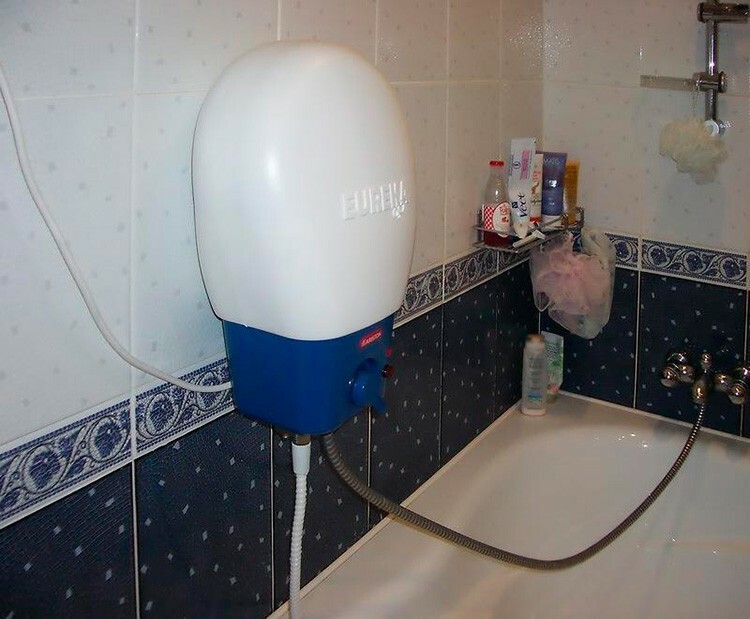
The disadvantages include the following indicators:
- for electric models - significant power leads to an increase in the consumption of electrical energy and, as a result, to an increase in the cost of paying bills for its consumption;
- for gas models - the need for a system for removing exhaust gases generated during use;
- for connection to utility networks (electrical and gas communications), it is necessary to observe certain Rules both in relation to the connection point and the further operation of the corresponding equipment.
FOR YOUR INFORMATION!
With regard to electrical models, it is necessary to comply with the "Electrical Installation Rules" (PUE) and the "Rules for Technical operation of electrical installations of consumers "(PTEEP), and in relation to gas models -" Safety rules in the gas industry "(PB 12-368-00).


The device and principle of operation of boilers of various types
Water heaters differ in design and method of heating water, types of fuel used, as well as type of performance and technical characteristics.
Boilers for indirect heating
This type of water heater uses the heating medium of the heating system as an energy source, to which the device is connected. The design of the indirect heating boiler is a container in which the coil is placed, connected to the heating system of a house (building or apartment), filled with water supplied for hot water supply.
There are models of this type, in which the design provides for the presence of not a coil connected to the heating system, but a second tank. In this case, the heat transfer method is called "tank in tank".

The heating medium of the heating system, passing through the coil, gives off its heat to the water in the water heater body, which heats up at the same time. The circulation of heated water is carried out by means of recirculation due to its heating, or by means of a circulation pump, the work of which is linked to the flow rate of heated water. The advantages of this type of boilers are:
- there is no need to tap into the gas main and connect to the electrical network;
- long service life due to the fact that the heating circuit does not come into contact with tap water;
- warm water can be used at different stages of its heating.

The disadvantages of this design include:
- dependence on the operation of the heating system;
- for inclusion in the work requires significant preparatory measures related to ensuring heated water supply (recirculation or turning on the pump), affecting the cost of the entire complex works;
- high cost compared to electric and gas counterparts;
- a long period of time for the initial heating of the water;
- in the initial period of use, the temperature of the heating medium of the heating system decreases;
- significant overall dimensions suggest placement in a room specially equipped for this purpose, especially for large-volume models.
IMPORTANT!
For the possibility of year-round use of indirect heating boilers, manufacturers produce models equipped with a built-in electric heating element (TEN) used to heat water during the closing of the heating season.

Instantaneous water heaters
This type of boilers involves the use of external energy sources, which are electricity and gas, without the presence of a tank for storing water.

The main structural elements of water heaters of this type are:
- a housing that accommodates all other equipment;
- heating element: electric heating element or gas burner;
- a heat exchanger in which heat energy from a heat source is transferred to water passing through its structure;
- pipes for supplying and leaving water from the heat exchanger;
- control unit and settings of operating modes.
For models in which an electric heating element is combined with a tap, the temperature of the heated water is regulated by the amount of its supply.
The control unit can be equipped with a rotary regulator and a thermostat or an electronic system with an LCD display, depending on the class of the device, its price category.
Electric instantaneous water heaters cannot be used without a reliable grounding system.
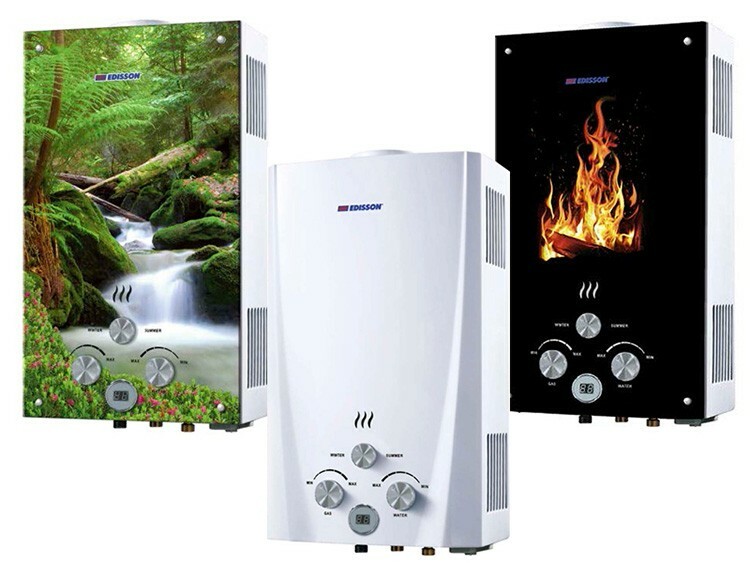
Electric models are of two types:
- pressure - when the water heater is connected directly to the cold water pipeline;
- gravity - installed autonomously (water is supplied manually or using a special pump).
Pressure models can serve several points of water intake, and non-pressure ones - only one.
The advantages of flow heaters are:
- compactness;
- high efficiency of use and thermal power.
The disadvantages include:
- significant electrical power for models powered by electricity;
- the need for sufficient water pressure - for gas models.
Storage water heaters
The very name of this type of boilers suggests that in the design of these devices it is assumed the presence of a tank designed to accumulate water, which heats up during operation water heater.
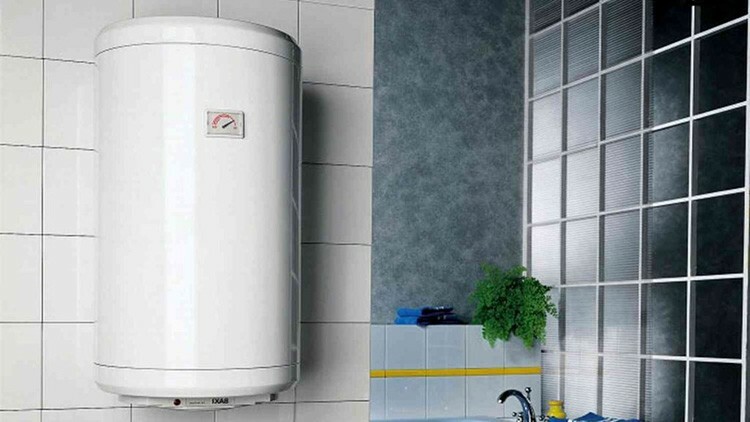
The main structural elements of the storage heater are:
- a case equipped with thermal insulation, in which the water storage tank is located;
- heating element: electric heating element or gas burner;
- control and protection units;
- nozzles for water inlet and outlet into the storage tank.
The operation of such equipment is based on principles similar to those for indirect heating devices (recuperation and circulation pump), and switching on is carried out in manual or automatic mode (for electrical models). The advantages of water heaters of this group are such indicators as:
- profitability;
- low electrical power - no need to lay additional group lines;
- the ability to heat large volumes of water in a short period of time - for gas models.
The disadvantages of storage boilers are:
- large overall dimensions;
- high cost compared to flow-through counterparts.
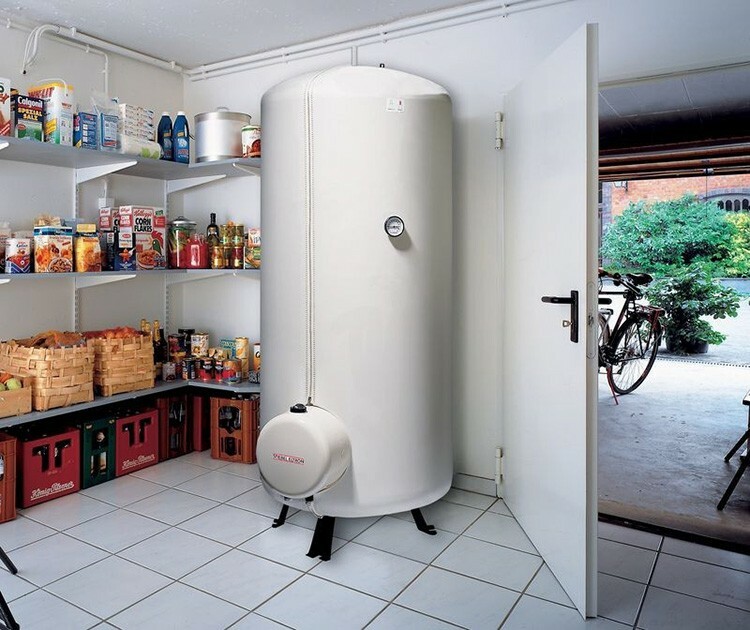
Water heaters by type of execution
According to this indicator, water heaters are suspended and floor type of installation, as well as combined type (for electric models), when the heating element is placed in a water outlet point (tap). As a rule, in the suspended version, flow-through and storage models are produced, equipped with a small-volume storage tank. Indirect heating devices and accumulative type of large volume of water are mounted on the floor.
How to choose a boiler - recommendations of our editorial staff
On the domestic market of water heaters, there is a wide selection of models from various manufacturers, differing in technical characteristics, types of fuel used and design. In this regard, it is sometimes difficult for an unprepared user to independently understand this variety and choose the right model for specific conditions of use.
When solving such a problem, our editorial staff recommend paying attention to the following points:
- Initially, you need to decide on what type of energy the water heater will work on, because all further steps will depend on this indicator.
- When choosing a storage type model, the volume of the storage tank should be sufficient for use for various needs and for all family members.
- If a large-volume storage type model is chosen, then it is necessary to think over its placement. It should be such that it is convenient to maintain the appliance and sufficient so that the boiler does not interfere with daily life.
- The electrical power of the selected device must correspond to the permissible load of the electrical network, reflected in the power supply contract, and the current load of protection devices and group electrical lines.
- When considering the issue of purchasing gas water heaters, it is necessary to consider the issue of removing waste gases generated during the operation of devices. And also to clarify the working pressure in the cold water supply network, which should be sufficient to open the gas burner valve.
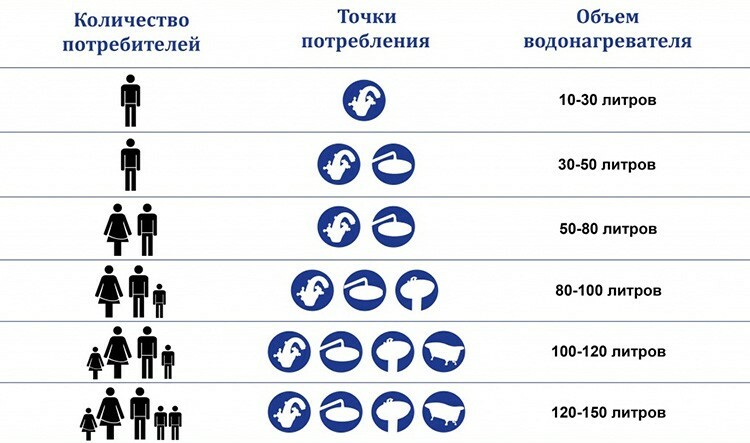
What to look for when choosing a water heater
Heater type. Water heaters can be flowing or cumulative. The first ones heat the water while it flows through the heating element, and the second ones first accumulate it in a special tank - a hydraulic accumulator, and heat it up there. Flow-through heaters are simpler, much more compact and usually cost less than storage heaters, however, they have higher power requirements and, say, you cannot connect a 10-kilowatt heater to a regular outlet. In turn, storage heaters can operate from a household outlet (if we are talking about electrical models, of course), are able to maintain a higher temperature with a stronger pressure of hot water, but take up much more space and are more difficult to service.
Food. The most popular type of water heater is electrical. This is not surprising, since they are inexpensive, easy to install and undemanding to maintain. In addition, this is the only option that is suitable for most apartments.
In private houses, the more rational option is often gas boilers. Household gas is cheaper than electricity, so the additional purchase and installation costs pay off pretty quickly.
Alternative to gas water heaters - solid fuel boilers. They heat water by burning wood, pellets, special briquettes and other solid fuels. These are best suited for private homes that are not connected to a centralized gas supply.
If, say, a gas boiler is already installed in the house, then a storage device can be connected to the heating system indirect heating. It uses a hot coolant that heats the water in the tank as it circulates through the pipes. The advantage of such a system is that there is no need to spend money on additional heating of water, although, of course, such boilers do not heat water too quickly.
Water heaters mixed type can use different fuels depending on the situation. For example, in winter, when the heating boiler is operating, the boiler is heated by it, and in summer, when there is no need for heating, it switches to gas. This is often the preferred option for private houses.
Combustion chamber type. Boilers can be equipped with closed and open combustion chambers. Open the chamber is the simplest option: ordinary atmospheric air is used here, and the combustion products are removed through the chimney. Accordingly, in order for the firebox to work constantly and safely, it is necessary to organize a separate room for the heater that meets the safety rules. Closed the chamber does not need a large chimney: here the combustion products are removed by means of forced ventilation, for which a small hole in the wall is enough - such a structure is usually more expensive, but it works more efficiently than open ones analogs.
Volume of the tank. The larger the tank, the more hot water is available to you. It is impossible to save on this parameter, because the lack of hot water is almost the same as its complete absence, and, say, nobody wants to wind up in the cold. You won't give exact numbers here, but for the kitchen, a model of 10-15 liters should be approximately enough for installation under the sink, and for the bathroom it is better to select a hydraulic accumulator at the rate of 30 liters per person - this is enough to calmly take a shower and not save.
Power. For a storage boiler, this is not a particularly fundamental parameter, because this device heats the water in advance. However, the power affects how quickly the device heats up the water and how much electricity it uses. Usually storage water heaters have a capacity of 1-2 kilowatts.
Tank shape. Tanks in heaters can be cylindrical, rectangular and flat. The first option is traditional and the most reliable, however, cylindrical tanks take up the most space. Rectangular tanks are much more compact but tend to leak at welds and are less tolerant of pressure drops than cylindrical tanks. Finally, flat accumulators can be placed almost anywhere, however, such slim tanks are much more expensive than analogues.
Tank material. The most reliable and popular option is stainless steel. Such a tank will last for years, even if you have to fork out a little for it. In addition, there are water tanks covered from the inside with glass ceramics (budgetary, but short-lived), as well as titanium, aluminum and other materials - it all depends on the manufacturer.
Heating element type. The heating element in the boiler can be made in "dry" and "wet" format. "Wet" ten is a metal tube with a heating coil inside, which is in direct contact with the water in the tank. In a "dry" heating element, the heating element is enclosed in a hermetic capsule and does not come into contact in water by itself. The second option does not collect scale, therefore it is preferable in places with hard water.
Control type. The choice between electronic and mechanical control should be made based on the budget: electronic control is more convenient and intuitive, but mechanical control is usually cheaper and often more reliable.
Accommodation. The larger and, accordingly, heavier the water heater, the more likely it is better to install it on the floor. Wall-mounted models rarely supply tanks with more than 100-150 liters: everything that is larger is already floor-standing options.
Rating of the best water heaters
The best storage combined water heater
1. Drazice OKCV 160

A relatively inexpensive, but roomy and efficient storage water heater with a price of about 27,000 rubles. Uses both indirect heating and electric. Ceramic dry heating element with a power of 2 kW provides a fairly quick and effective heating of water to a maximum of 80 degrees. A tank with a volume of 152 liters is enough even for a large family, just keep in mind that not every wall can withstand such a structure. Protection against overheating and overpressure is provided, as well as a magnesium anode to combat scale. The main drawback of this device is its bulkiness, but this is a reasonable price to pay for reliability and comfort.
Price: ₽ 21 600
Drazice OKCV 160
The best storage gas water heater
2. Ariston S / SGA 100

Storage gas water heater with an open combustion chamber, equipped with a piezo ignition and a gas control system. A hydroaccumulator with a volume of 95 liters is enough for a family of two or three people, while the thermal power 4.4 kW is enough to heat the contents of the tank to the maximum temperature for an hour and a half. The mechanical control system works reliably and without interruption. Overheating protection is provided, a protective magnesium anode is installed to combat scale. The inside of the tank is covered with branded enamel. With a price of 22,000 rubles, it is a good choice for a small private house or summer cottage.
Price: ₽ 21 990
Ariston S / SGA 100
The best water heater for an apartment
3. Zanussi ZWH / S 80 Splendore XP 2.0

An electric storage-type water heater, which, at a price of less than 13,600 rubles, is ready to fully meet the needs of a small family for hot water. An 80-liter hydroaccumulator is enough for two or three people to shower. The power of 2 kilowatts is enough to heat a full tank to a maximum of 75 degrees in about an hour and a half. Convenient and intuitive electronic control. An emergency shutdown system, an anti-freeze mode and a safety valve are provided. Reliable and durable stainless steel tank. Antibacterial water disinfection system.
Price: ₽ 13 660
Zanussi ZWH / S 80 Splendore XP 2.0
The best storage indirect water heater
4. Hajdu ID 25A
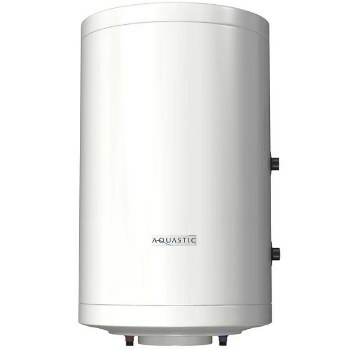
Storage water heater for indirect heating. The 14,500 rubles spent on the purchase of this unit will quickly pay off due to the fact that it takes heat from the heating system to heat the water. The maximum temperature for heating water depends on the temperature of the coolant in the system, but should not exceed 95 degrees. The water in a 100-liter tank is more than enough for a family of two or three people. The inside of the tank is enamelled and ready for a long, leak-free service. A magnesium anode fights scale. One of the best options for a small private house with its own heating boiler.
Price: ₽ 14 530
Hajdu ID 25A
The best instantaneous electric water heater
5. Thermex Topflow Pro 21000

Electric water heater of flow type. Three heating elements with a total capacity of 21 kilowatts provide the device with a decent performance of 11.8 liters per minute. The device is designed to operate in a three-phase network with a voltage of 380 volts (naturally, at this power). The heater is equipped with an electronic control system with an LCD display and is able to automatically maintain the desired leaving water temperature. Protection against switching on without water and overheating is provided. With a price in the region of 14,500 rubles, it is one of the best flow heaters on the market.
Price: ₽ 14 490
Thermex Topflow Pro 21000
Best storage electric water heater
6. Thermex Flat Plus Pro IF 50V
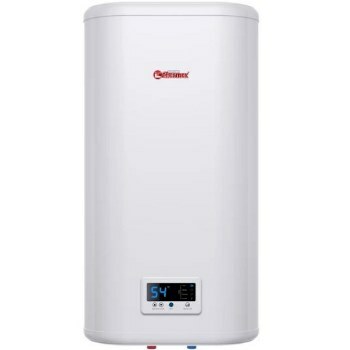
A relatively small storage water heater with a 50 liter tank, which can be placed even in a small bathroom in a typical apartment. The volume of the accumulator is enough for one or two people. Paired heating elements with a total capacity of 2 kilowatts are capable of heating water to a maximum of 75 degrees in just a couple of hours. Electronic control with indication of inclusion and heating. The functions of self-diagnosis, protection against electric shock, against switching on without water, overheating and freezing are provided. Stainless steel tank designed for years of use. The price of the issue is less than 14,000 rubles.
Price: ₽ 14 090
Thermex Flat Plus Pro IF 50V
The best water heater for home
7. Zanussi GWH 10 Fonte Turbo
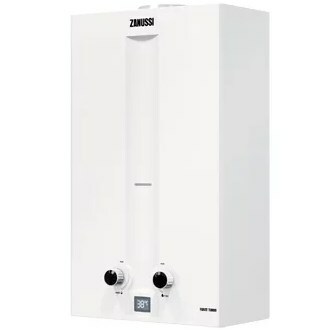
Inexpensive instantaneous gas water heater with a price of less than 9,000 rubles. The thermal power of the device is 20 kilowatts, which makes it possible to provide a productivity of 10 liters per minute - this is more than enough for most household needs. Reliable and simple mechanical control, electronic ignition, efficient and reliable copper heat exchanger, bright informative display. The heater requires a 60 mm chimney for operation. Protection against overheating and freezing is provided. The column works quietly and efficiently, turns on quickly and heats the water almost instantly. The most is for a private house or summer cottage.
Price: ₽ 8 790
Zanussi GWH 10 Fonte Turbo
The best instantaneous gas water heater
8. BaltGaz Classic 10
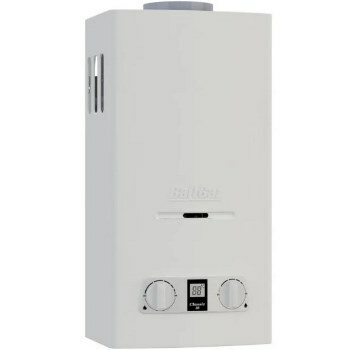
Another instantaneous water heater running on domestic gas. This device costs a little less than the previous one - around 8,500 rubles - but it is not inferior in performance. The thermal power of the device is 17.9 kilowatts, which gives 10 liters of hot water per minute at the outlet. The ability to work on liquefied gas makes this boiler an excellent choice for a private house or summer cottage, even without being connected to a centralized gas supply. Open combustion chamber, electronic ignition, simple mechanical control and LCD temperature display. A reliable device without unnecessary functionality.
Price: ₽ 8 300
BaltGaz Classic 10
The best heating tap
9. PROFFI Smart PH8841
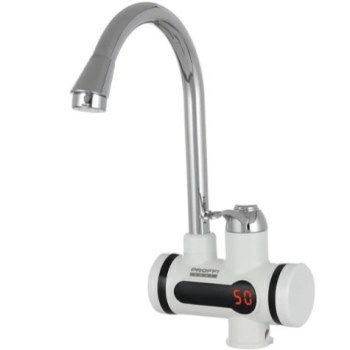
Nice and inexpensive instantaneous water heater made in the mixer form factor. Power of 3 kilowatts is enough to heat water up to 60 degrees. The water temperature is signaled by a bright backlit display. Protection against switching on without water and overheating is provided. Basic mechanical control: using this boiler is no more difficult than using a regular water tap. Works from a regular household outlet, which is rare for instantaneous water heaters. An excellent budget option worth about 5500 rubles, which will look great anywhere at a construction site or in the country.
Price: ₽ 5 362
PROFFI Smart PH8841
How to calculate the volume of a water heater
One of the conditions for a successful purchase of a boiler is the correct choice of the model in terms of the volume of the storage tank or its performance. To determine the required capacity of the storage tank, you can use the tables that can be found on the Internet or by calculating using the following formula:
V = N × ((t0 - t1) / (t2 - t1)), where:
V - boiler volume (l);
N - water consumption per unit of time (l / minute);
t0 - temperature at the point of draw-off;
t1 - the temperature of the water in the water supply;
t2 - the temperature of the water leaving the boiler.
Water consumption per unit of time depends on the number of taps (taps) and the types of equipment using hot water (shower, bath, washing machine, dishwasher, etc.).
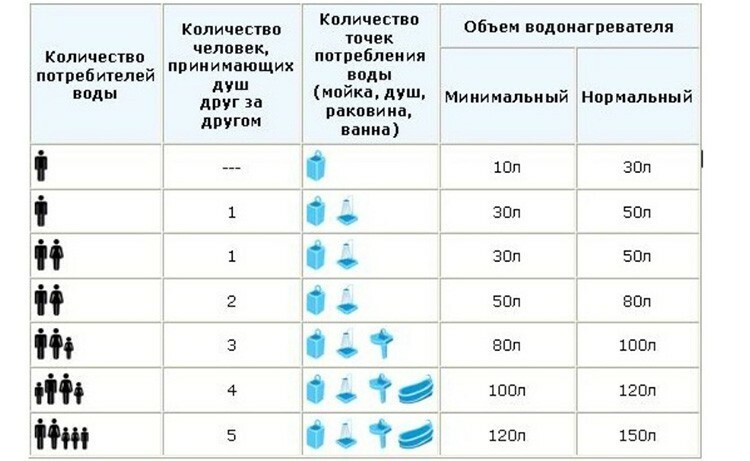
FAQ
Which water heater is best for a large family?
The best option is a storage heater with a stainless steel tank of 100 liters or more. If the family lives in a city apartment, then it should be an electric model with a capacity of 2-2.5 kilowatts, and for a private at home, a combined type boiler is best suited, capable of heating water using gas or indirect heating.
Video: How to use a water boiler
How to use the water heater correctly is always described in detail in the operating instructions for a particular model, however, in in the next video, we will tell you how to use a boiler, and we hope that this will be useful in the first stages of using such equipment.
Read also:
Instantaneous electric water heater for shower: we increase the comfort of summer cottage life
Hot and even hotter: why Russians increasingly choose the Electrolux gas water heater to heat water
A hot alternative to cold water outages - how will a gas storage water heater help a thrifty owner?
How to properly drain the remaining water from the boiler so as not to damage the device


